Clematis "Blue Angel": description and cultivation

Each owner of a personal plot tries to decorate his territory as effectively and uniquely as possible. In the gardens of modern summer residents, you can see not only vegetable and fruit crops, but also beautiful flower beds and green compositions, on which the variety of plants and their colors sometimes surprises even professional florists. Breeders are constantly working on the development of new varieties of flowers. Despite this, clematis has remained the favorite inhabitant of the garden for many years. Its varietal and color variety allows the creation of unique flowering objects. Florists recommend that beginner gardeners pay attention to the Blue Angel variety, which will delight with pale blue flowers throughout the summer season.
Peculiarities
Clematis "Blue Angel" is a beautiful variety of the buttercup family, bred by Polish breeders in 1989. A detailed description of the Blue angel can be found in various books on botany. This species belongs to the late varieties with large flowers. The maximum height of an adult plant growing in a comfortable environment can reach 4 meters. On thin and curly stems are rich green trifoliate leaves, which have an opposite arrangement and a wide asymmetric plate. The fibrous root system has a soft structure and cord-like branches.
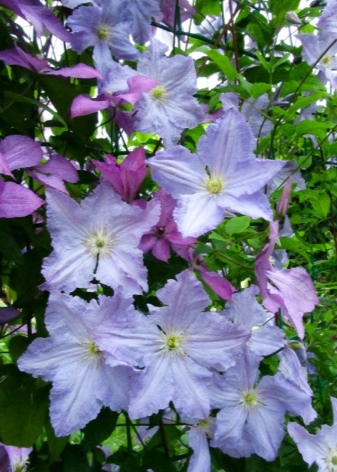
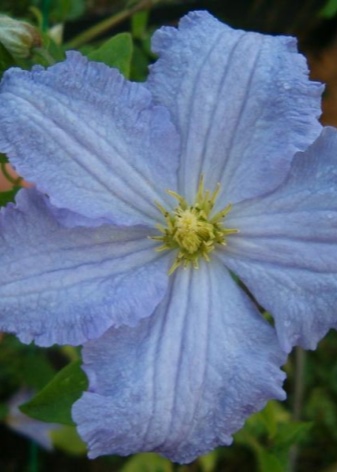
The flowers are painted in a pale blue hue and mainly consist of 6 sepals. The standard width of one flower is 4 cm, length is 6 cm, and diameter is 14 cm, but deviations from the norm are also common. A distinctive feature is wavy edges, the presence of yellow stamens and a complete lack of aroma. Flowers form from July to September only on shoots that appear in spring.
Blue Angel is a frost-resistant variety that can withstand temperatures as low as -35 degrees.
Clematis "Blue Angel" has the following advantages:
- abundant and stable flowering;
- fast green mass gain;
- resistance to low temperatures;
- long flowering period.
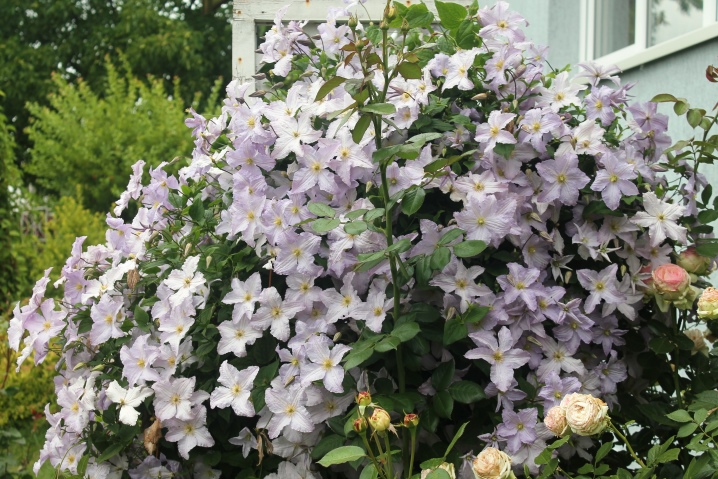
How to plant?
In order for the Blue Angel to please with abundant flowering and bright greenery throughout the season, experts recommend paying special attention to choosing a landing site. The plant feels comfortable in sunny areas that have little shade in the midday heat. Preference should be given to areas on the south or southwest side. Clematis should be planted in light, fertile soils with low acidity. The landing site must be protected from strong air currents. Unfavorable landing sites are areas near walls and fences.

Important! Before starting the planting work of the vines, it is imperative to think over the support system along which the plant can curl. This design can be purchased, made independently, or adapted for weaving nearby trees and tall shrubs.
The plant chosen for spring planting must have at least one young shoot, as well as be resilient and free from mechanical damage. If the roots have dried up during transportation, then before planting, it is better to soak them for 2 hours in water with potassium permanganate dissolved in it, treat with accelerators of growth and formation of the root system. The planting hole must have a depth and diameter of at least 55 cm.To prevent decay of the root system, experts recommend placing crushed brick, pebbles or special drainage material at the bottom of the recess.
It is necessary to fill the plant with nutritious soil, which should consist of compost, peat, sand, superphosphate and dolomite flour.
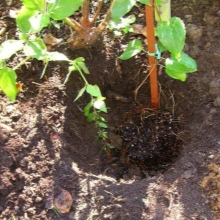
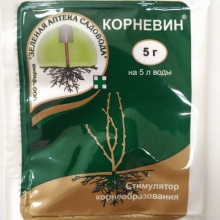

When planting clematis, it is necessary to try to straighten the root system as much as possible and very carefully fill all the voids with soil so as not to damage the delicate root processes. The root collar should be located 10 cm below ground level. The planted shoot must be watered abundantly with water, and the root zone must be mulched with peat. The optimal distance between the plants is 100 cm. In order for the roots of the plant to experience a minimum amount of stress when overheating, florists recommend planting phlox, peonies and marigolds throughout the root zone.
Important! The best time for autumn planting is the end of autumn. The planting material must necessarily have vegetative buds. The autumn planting process is similar to the spring planting, but after planting the seedlings, they must be covered with a non-woven covering material.
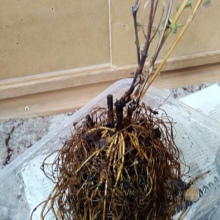
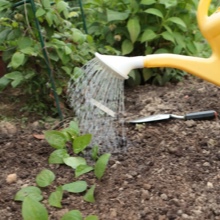
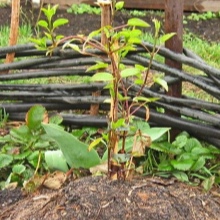
Correct care
"Blue Angel" refers to unpretentious varieties that require a certain amount of attention. Caring for this variety consists of several manipulations.
- Watering. To provide an adult clematis with moisture, it is necessary to pour about 20 liters of water into one landing at least twice a week. Young flowers can be watered once a week. The volume of water can be adjusted according to the type of soil and the degree of water penetration into it. The main thing is that the soil is soaked to a depth of 70 cm. The indicator of the need for watering is the condition of the soil at a depth of 15–20 cm. If the soil is wet, then the procedure should be postponed.
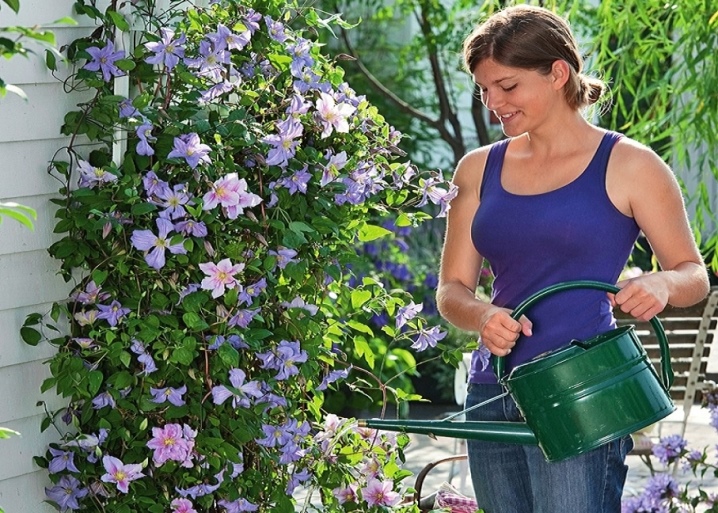
- Top dressing. You should start feeding the plant only two years after planting. In the spring, the flower needs nitrogen fertilizers, at the time of bud formation, it is necessary to enrich the soil with potassium, and at the beginning of autumn, phosphorus should be added. In spring, "Blue Angel" can be poured with a solution of flour and chalk, and during the autumn rains, it is better to cover the root zone with ash, which will turn the formation of putrefactive bacteria. It is strictly forbidden to use fresh manure and sour peat as top dressing.
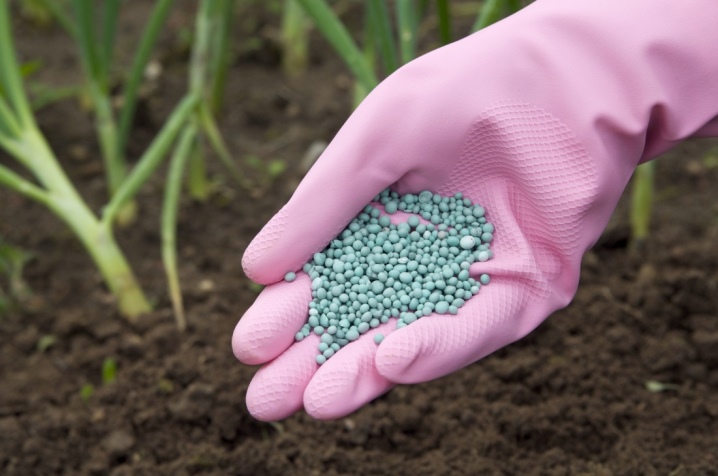
- Loosening and mulching. To maximize the enrichment of the root system with oxygen, after each watering or rain, it is imperative to loosen the soil. If the root zone is covered with a thick layer of mulch, then you can not only avoid weeding, but also improve the condition of the soil. Straw can be used as mulch, but it can attract rodents. It is better to give preference to tree bark, which will reliably cover the soil for 3 years.
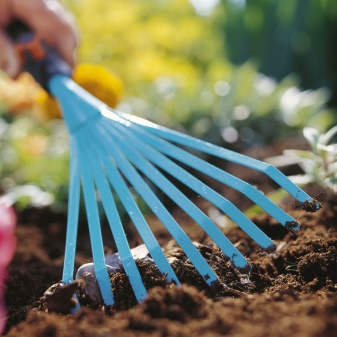
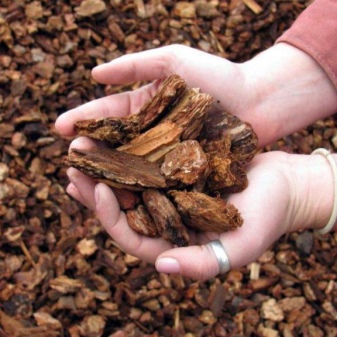
- Pruning. In order for the Blue Angel to present a large number of flowers in the spring, experts strongly recommend pruning the vines in the fall. This event belongs to the third group of pruning and provides for the maximum removal of old shoots. To perform these works, it is necessary to purchase a sharp cutting tool and a disinfectant solution, with which the secateurs must be periodically wiped during the work process. After pruning, shoots should grow from the central trunk, the size of which does not exceed 20 cm. Only in this case, in spring, the flower will give the maximum increase in green mass and will delight you with a large number of flowers. Some experienced gardeners recommend cutting not all shoots, but after one.
This method of pruning will not only rejuvenate the bush, but also allow the inflorescences to be evenly distributed on it.
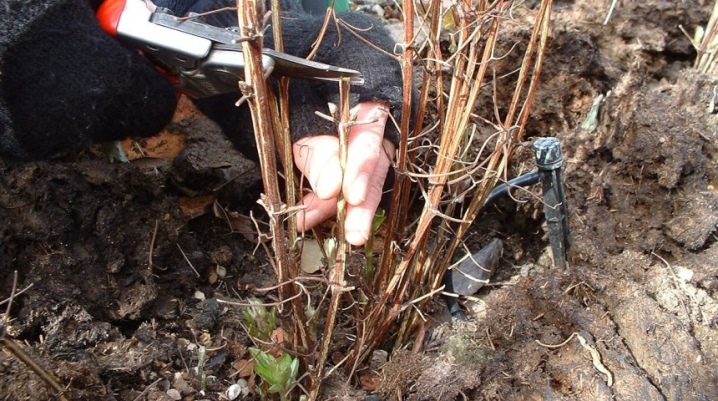
- Preparing for winter. At the end of autumn, it is imperative to prepare the plant for wintering. The pruned bush can be covered with spruce branches or non-woven material to protect the shoots from ice and prevent them from rotting. In the spring, it is necessary to open the shelter gradually, trying to avoid sunburn.


Reproduction methods
To get new shoots on your own, experts recommend using the method of dividing the bush. It is this breeding method that will allow you to get healthy and strong planting material. To separate the shoots from the mother bush, you need to dig out the part of the plant you like without digging the plant with a shovel and immediately plant it on the selected site. If the root system has a strong interlacing, then it is better to remove the mother bush and cut off the seedlings with a pruner.
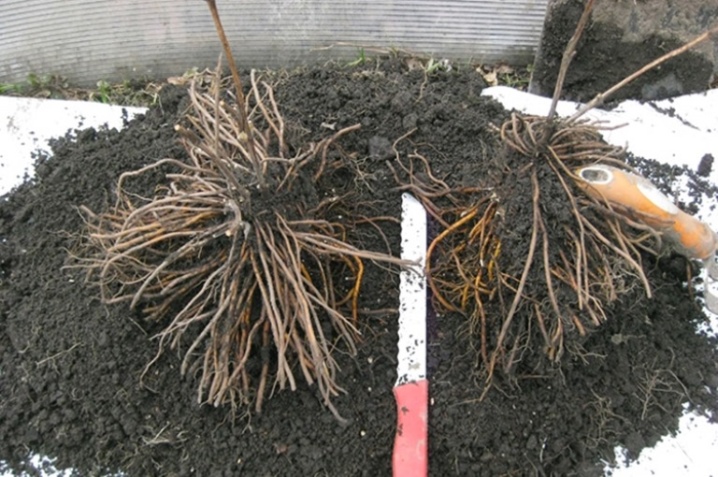
Large nursery workers often use seed propagation, which is more time-consuming and requires a specific set of knowledge and practical skills. For planting, you can use only seeds collected in the current year, which were stored at a temperature not higher than +23 degrees in a paper bag. The optimal time for planting is March and April. Before planting, it is better to soak the seed for a week in clean water at room temperature, which must be changed every other day. This procedure will allow seedlings to appear faster.
Planting containers should be filled with nutrient soil, which should consist of equal parts of turf, sand and peat. On the moistened soil, it is necessary to carefully lay out the soaked seeds and fill them with 3 cm of river sand, which must be slightly compacted. To create a greenhouse effect, containers must be covered with plastic wrap or glass. In a room with planting containers, the temperature must be at least +25 degrees. Immediately after the appearance of the first shoots, the covering material must be removed, and the containers must be placed in sunny areas.
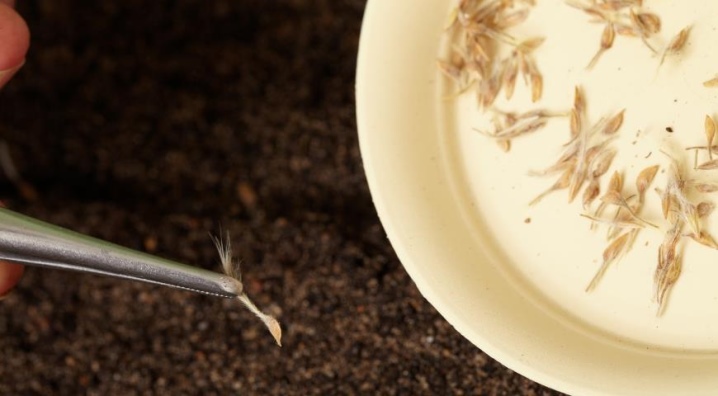
After the appearance of the first leaves, the seedlings must be cut into separate containers. If weather conditions allow, then transplanting young plants can be carried out directly into the open ground. The optimum distance between plants is 20 cm. To accelerate the development of the root system and increase the number of shoots, experts recommend regularly pinching the crown. Only after 3 years can young plants be transplanted to a permanent place of growth.
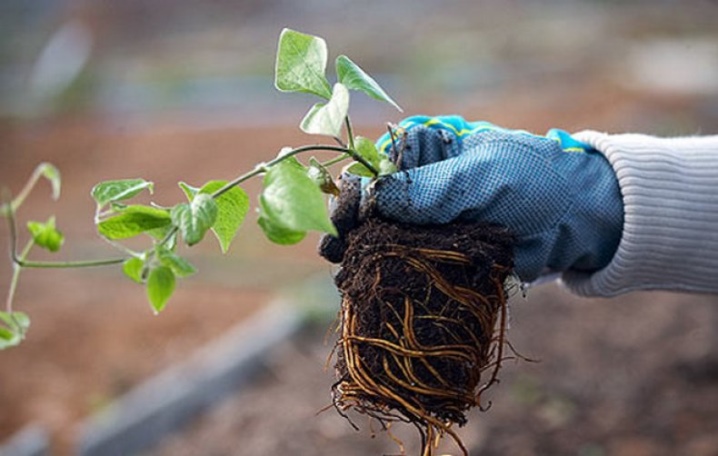
Diseases and pests
Due to its genetic characteristics, this variety is resistant to most known diseases, but he can be affected by the following diseases:
- withering;
- powdery mildew;
- rust;
- alternaria;
- ascochitis;
- cylindrospoliosis.
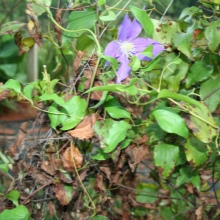
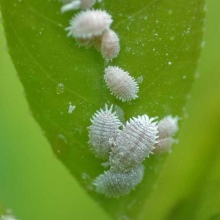

The first signs of fungal diseases are the loss of tissue elasticity, their wilting and the rapid drying of the entire plant. If orange growths appeared on the leaves and shoots, which after a while led to darkening of the leaves and deformation of the shoots, then this is a clear sign of rust. If the above signs are found, it is necessary to immediately treat the plant and the soil around it with special chemicals. Unfortunately, it will not work to get rid of the yellow mosaic. To prevent the spread of the disease, it is necessary to completely dig up the diseased bush and burn it.
To minimize the risk of disease, florists do not recommend planting clematis next to hosts, sweet peas, delphinium, aquilegia, phlox and peonies. Clematis is very rarely affected by pests, but to prevent the appearance of a spider mite, it is better to periodically spray the leaves with cold water.
A fine mesh installed near the vine will protect the flower from the invasion of rodents in winter.
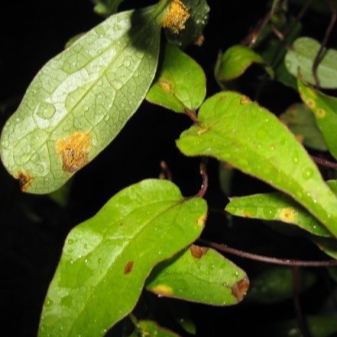
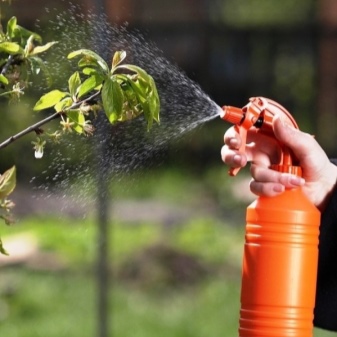
Examples in landscape design
For many years, clematis has taken a leading position in the ranking of the most popular flowering plants. It is he who is able to please his owners throughout the summer. Summer gazebos, recreation areas and building facades are decorated with blooming liana. Even the usual support, along which the Blue Angel weaves, becomes a bright spot of any personal plot.
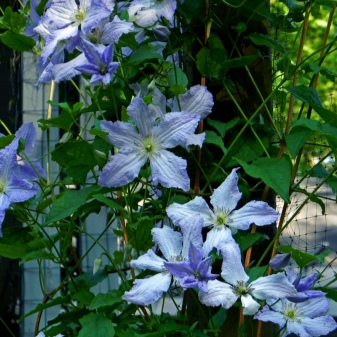

Many gardeners replace traditional supports with arches, along which the vine is subsequently woven.The main thing is that the pipe diameter does not exceed 20 mm, and the material is light and dense. If the structure is supplemented with a metal mesh, then you can get a very beautiful and evenly blooming green composition.
Experts recommend using several varieties of clematis with different flowering periods in their compositions., then the plants will decorate the site from early spring to late autumn.
A spectacular and unusual art object will definitely be the roof of a summer gazebo, braided by a flowering plant.
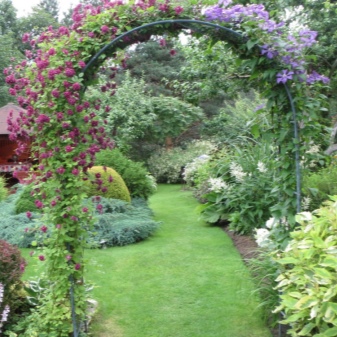
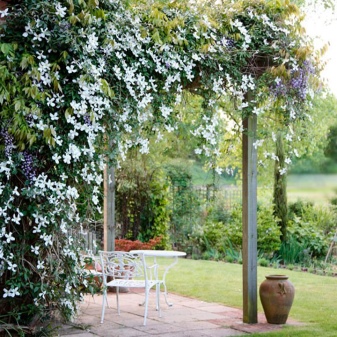
A successful combination will be the simultaneous planting of clematis and roses. These plants not only harmoniously complement each other, but also do not inhibit the growth of neighbors. The plant is also good for the neighborhood with maiden grapes, honeysuckle, hops, lemongrass and actinidia.
The latest design decision in the field of landscape design is to plant this variety in suspended or portable flowerpots that can be moved depending on the style of the site and the desires of the owners.

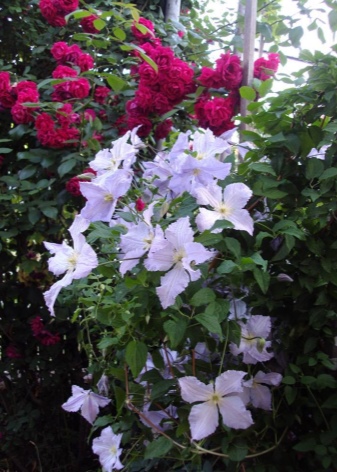
For information on how to grow Blue Angel clematis, see the next video.







































































































The comment was sent successfully.